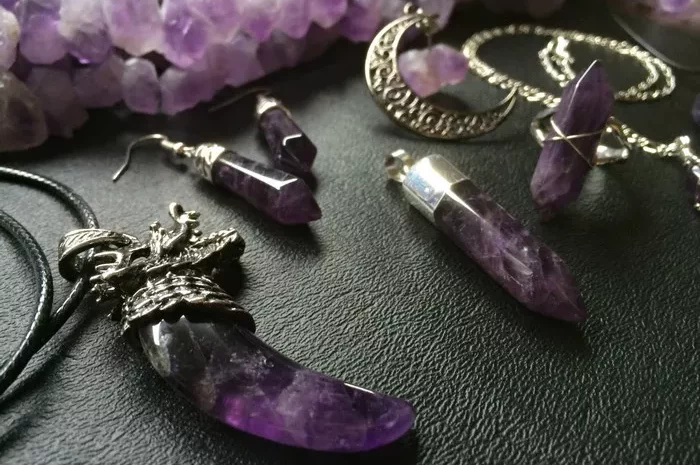Evaluating the price of an amethyst necklace involves a comprehensive analysis of several factors, including but not limited to the quality of the amethyst, its origin, the design and craftsmanship, market demand, and the overall condition of the necklace. Here, we provide a detailed and logical introduction to the process, broken down into several subsections for better understanding.
Quality of the Amethyst
The quality of the amethyst is a crucial factor in determining the price of the necklace. High-quality amethyst is characterized by its vivid color, clarity, and transparency. The color of amethyst can range from a light lilac to a deep, rich purple, with the more intense and uniform colors generally commanding higher prices. Clarity refers to the absence of inclusions or imperfections within the stone, and the more flawless the amethyst, the higher its value. Additionally, the transparency or translucency of the amethyst can also impact its price, with more transparent stones being more sought after.
Origin of the Amethyst
The origin of the amethyst can also affect its price. Some regions are known for producing higher-quality amethyst, such as Brazil, Uruguay, and Zambia. These regions are often associated with amethyst that has a more intense color, better clarity, and larger crystal sizes. As a result, amethyst from these areas may fetch a higher price compared to amethyst from other regions. However, it’s important to note that origin alone does not determine the price; the quality of the amethyst is still the primary factor.
Design and Craftsmanship
The design and craftsmanship of the amethyst necklace are essential elements in determining its price. A well-designed necklace, with intricate details and high-quality craftsmanship, will generally be more expensive than a simpler design. The setting of the amethyst, whether it’s in a gold, silver, or platinum mount, can also impact the price. More precious metals and complex settings will increase the overall cost of the necklace.
Market Demand
Market demand plays a significant role in determining the price of amethyst necklaces. When amethyst is in high demand, prices tend to increase. Conversely, when demand is low, prices may decrease. Fashion trends, economic conditions, and consumer preferences can all influence market demand for amethyst jewelry. For instance, if amethyst is featured prominently in fashion magazines or worn by celebrities, it may spark increased interest and demand, thereby driving up prices.
Overall Condition
The overall condition of the amethyst necklace is another important consideration. A necklace that is in pristine condition, with no scratches, chips, or discoloration, will be more valuable than one that shows signs of wear and tear. Even small imperfections can significantly reduce the price of a piece of jewelry.
Additional Factors
In addition to the factors mentioned above, there are several other considerations that can influence the price of an amethyst necklace. These include the size and weight of the amethyst, the rarity of the stone, and any special features or history associated with the necklace. Larger amethyst stones are generally more expensive than smaller ones, as are stones that are rare or have unique characteristics. Necklaces with a rich history or provenance, such as those belonging to famous individuals or having been featured in significant events, may also command a higher price.
Evaluating the Price: A Step-by-Step Guide
Assessment of the Amethyst: Begin by examining the amethyst itself. Look for vivid color, clarity, and transparency. Use a loupe or magnifying glass to check for inclusions or imperfections. Compare the quality of the amethyst to industry standards and price guides.
Origin Analysis: Research the origin of the amethyst. Determine whether it comes from a region known for producing high-quality amethyst. Consider how the origin may affect the perceived value and market demand for the stone.
Design and Craftsmanship Evaluation: Assess the design and craftsmanship of the necklace. Look for intricate details, high-quality metals, and expertly set amethyst. Consider how the design and craftsmanship contribute to the overall aesthetic and value of the piece.
Market Research: Conduct market research to understand the current demand for amethyst jewelry. Look for trends in fashion, economic conditions, and consumer preferences that may impact the price. Compare the price of similar necklaces on the market to get a sense of the going rate.
Condition Check: Carefully examine the overall condition of the necklace. Look for signs of wear and tear, such as scratches, chips, or discoloration. Consider how the condition may affect the value and marketability of the piece.
Additional Factors Consideration: Take into account any additional factors that may impact the price, such as the size and weight of the amethyst, its rarity, and any special features or history associated with the necklace.
Conclusion
Evaluating the price of an amethyst necklace is a complex process that involves considering multiple factors. By carefully assessing the quality of the amethyst, its origin, the design and craftsmanship, market demand, and the overall condition of the necklace, you can gain a comprehensive understanding of its value. Remember that jewelry pricing is not an exact science, and prices can vary depending on the specific circumstances of each piece. As a jewelry appraiser, your expertise and experience in evaluating these factors will be crucial in determining a fair and accurate price for the amethyst necklace.
Related topic:
- What Is the Meaning of Amethyst Necklace?
- Levian Pink Amethyst: A Gemstone with a Touch of Elegance
- Pink Amethyst Earrings: A Guide to Authenticity and Value


